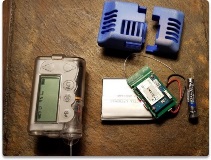Three Do-It-Yourself (DIY) Artificial Pancreas System Resources
Oct 22, 2019, 14:29 PM
by Julia Blanchette, BSN, RN, CDE, PhD Candidate
Frances Payne Bolton School of Nursing
Case Western Reserve University
Do-it-yourself (DIY) artificial pancreas systems are gaining popularity among people who live with insulin-dependent diabetes. DIY systems give greater flexibility and personalization in insulin settings than current, commercially approved insulin delivery systems. Although commercial systems work well for some, others feel that the DIY systems relieve self-management decision making burden and significantly reduce glucose variability.
Often, people who use DIY systems know much more about their intricacies than diabetes providers. As more people with diabetes begin to use these systems it is essential for diabetes care and education specialists to stay ahead of the technology curve. I currently use a DIY system, and one of the main reasons for using it originally was to understand the system and how to help my patients. But, where did I go to start learning about these systems?
First, I recommend reading the Artificial Pancreas Book, especially if you have little understanding of DIY systems or are apprehensive about caring for people who use these non-FDA approved devices. The Artificial Pancreas book brings in the knowledge from the DIY movement founders and real-life DIY users. The book provides insight as to why the system is a better self-management choice than any other commercially available device for those who share their stories.
After gaining some insight as to what DIY systems consist of and why people with diabetes choose to use them, I highly recommend digging right into the resources that users refer to build the systems: LoopDocs and OpenAPS. Both LoopDocs and OpenAPS explain the respective type of DIY system, how it works, and how to set it up. Paying attention to how the systems work is important to understand how different insulin settings may need to be changed to optimize the system and reduce glycemic variability further.
As you review LoopDocs and OpenAPS, it is essential to keep in mind that DIY systems differ from typical pumping when determining and adjusting insulin settings. For example, in Loop, the insulin sensitivity factor (ISF) is not used for hyperglycemia corrections, and may need to change for Loop. The ISF in Loop is used to calculate basal rate adjustments, along with other factors such as carbohydrate absorption time, carbohydrates on board, carbohydrate ratios, and target blood glucose. It is also essential to know that some systems, such as Loop, still require carbohydrate input from the user. Insulin action times are also different in these systems as they follow true insulin action curves.
It is also critical to make sure that DIY users have diabetes backup plans. Often when these systems fail, users may be unsure of their backup insulin doses. It is also vital to still look at patient data — just because someone is using a DIY system, it doesn’t mean that they aren’t experiencing hypoglycemia or glycemic variability. Data from these systems can be reviewed through Nightscout or Tidepool. As diabetes care and education specialists, it is not only critical to understand how these systems work and how to support those who use them.
All the resources discussed here are part of the featured resources available on danatech, a website dedicated to diabetes technology education and information that is free for AADE members. To access and learn more about these resources, visit danatech.org/resources and login using your AADE login credentials.
AADE Perspectives on Diabetes Care
The American Association of Diabetes Educators Perspectives on Diabetes Care covers diabetes, prediabetes and other cardiometabolic conditions. Not all views expressed reflect the official position of the American Association of Diabetes Educators.
Copyright is owned or held by the American Association of Diabetes Educators and all rights are reserved. Permission is granted, at no cost and without need for further request, to link to, quote, excerpt or reprint from these stories in any medium as long as no text is altered, and proper attribution is made to the American Association of Diabetes Educators.
HEALTHCARE DISCLAIMER: This site and its services do not constitute the practice of medical advice, diagnosis or treatment. Always talk to your diabetes care and education specialist or healthcare provider for diagnosis and treatment, including your specific medical needs. If you have or suspect that you have a medical problem or condition, please contact a qualified health care professional immediately. To find a diabetes care and education specialist near you, visit DiabetesEducator.org/Find.